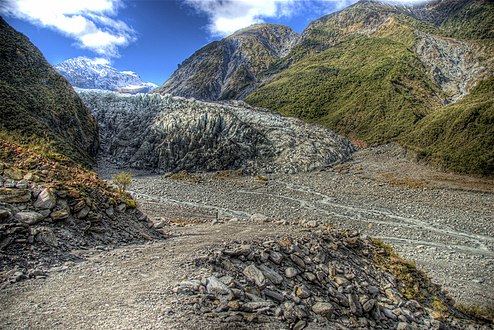Fox glacier
| Fox glacier | ||
|---|---|---|
|
Glacier tongue of Fox Glacier in March 2007 |
||
| location | New Zealand , South Island | |
| Mountains | New Zealand Alps | |
| Type | Valley glacier | |
| length | 13.2 km | |
| surface | 34.69 km² | |
| Exposure | Nutrient area: northwest; Consumption area: West | |
| Altitude range | 3500 m - 305 m | |
| Coordinates | 43 ° 32 ' S , 170 ° 9' E | |
|
|
||
| drainage | Fox River, Tasman Sea | |
The Fox Glacier ( English Fox Glacier , Māori : Te Moeka o Tuawe ) is a valley glacier near the west coast of New Zealand's South Island . It is located within Westland National Park . Its nutrient area is in the area of the highest peaks in the New Zealand Alps and, like the Franz Josef Glacier , 25 km further north, it flows from there down the steep western flank of the mountains and therefore extends far down, almost to 300 m.
In 1852 Leonard Harper named Franz Josef and Fox Glaciers after Victoria and Albert , the English royal couple at the time, but did not make this officially known. So it came about that today both have different names. After the New Zealand Prime Minister William Fox paid a visit to the two glaciers in 1872, the Fox Glacier got its current name.
The Fox Glacier drains into the Tasman Sea via the Fox River . Due to the proximity of the Fox Glacier Village , the glacier is well developed for tourism. A little south of the village branches off from State Highway 6 to the southeast, about seven kilometers long driveway, via which one can get to the vicinity of the glacier gate.
development
Fox Glacier suffered heavy losses for most of the 20th century. From 1985 to 2007 the glacier mainly expanded, but has been melting again since 2009 (as of 2014). The peak from around 2007–2008 can be seen particularly well on the southern slope due to a clearly visible vegetation boundary far above today's glacier tongue.
- Position of the glacier tongue of the Fox Glacier
The reason given for these fluctuations is the unusually high speed of the Fox Glacier and Franz Josef Glacier for glaciers. The Fox Glacier is advancing at one meter per week. As a result, the glacier reacts within a few years to several years of above or below average snowfall in the nutrient area, as is often caused by El Niño or La Niña . Added to this is the location on the west coast, which is rich in precipitation: “These are maritime glaciers on which westerly winds from the Tasman Sea carry up to 15,000 millimeters of precipitation per year. This allows them to grow quickly. At the same time, their tongues reach into very deep and relatively warm layers, so that they retreat quickly when the temperature rises. "
Individual evidence
- ↑ a b c d World Glacier Monitoring Service (WGMS): Fluctuations of Glaciers 2005–2010 (Vol. X). Zurich 2012 ( online ( memento of the original from March 5, 2014 in the Internet Archive ) Info: The archive link has been inserted automatically and has not yet been checked. Please check the original and archive link according to the instructions and then remove this note .; PDF; 5.0 MB )
- ↑ www.planetware.com: Fox Glacier
- ^ Fox and Franz Josef Glaciers . Fox Glacier Guiding. Retrieved August 10, 2014.
- ↑ a b El Nino could help glaciers . In: The New Zealand Herald , May 15, 2014. Retrieved August 10, 2014.
- ↑ Glacier visitors ignore 'extreme risks' . In: The New Zealand Herald , January 12, 2006. Archived from the original on January 27, 2010. Retrieved September 30, 2011.
- ↑ Confusing exemplary glaciers . In: Deutschlandfunk , March 29, 2011. Accessed August 10, 2014.
See also
Web links
- Department of Conservation - Fox Glacier area



